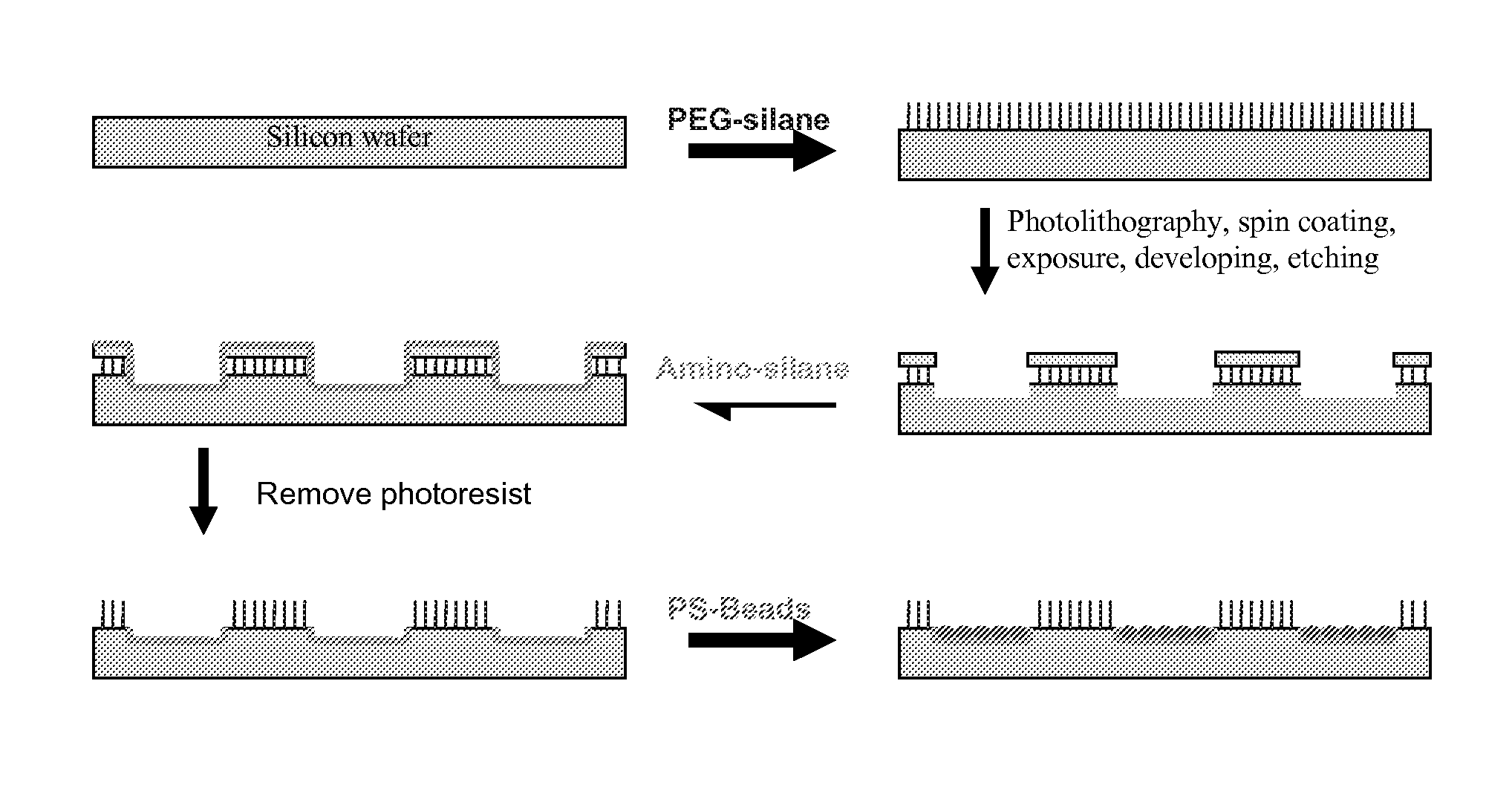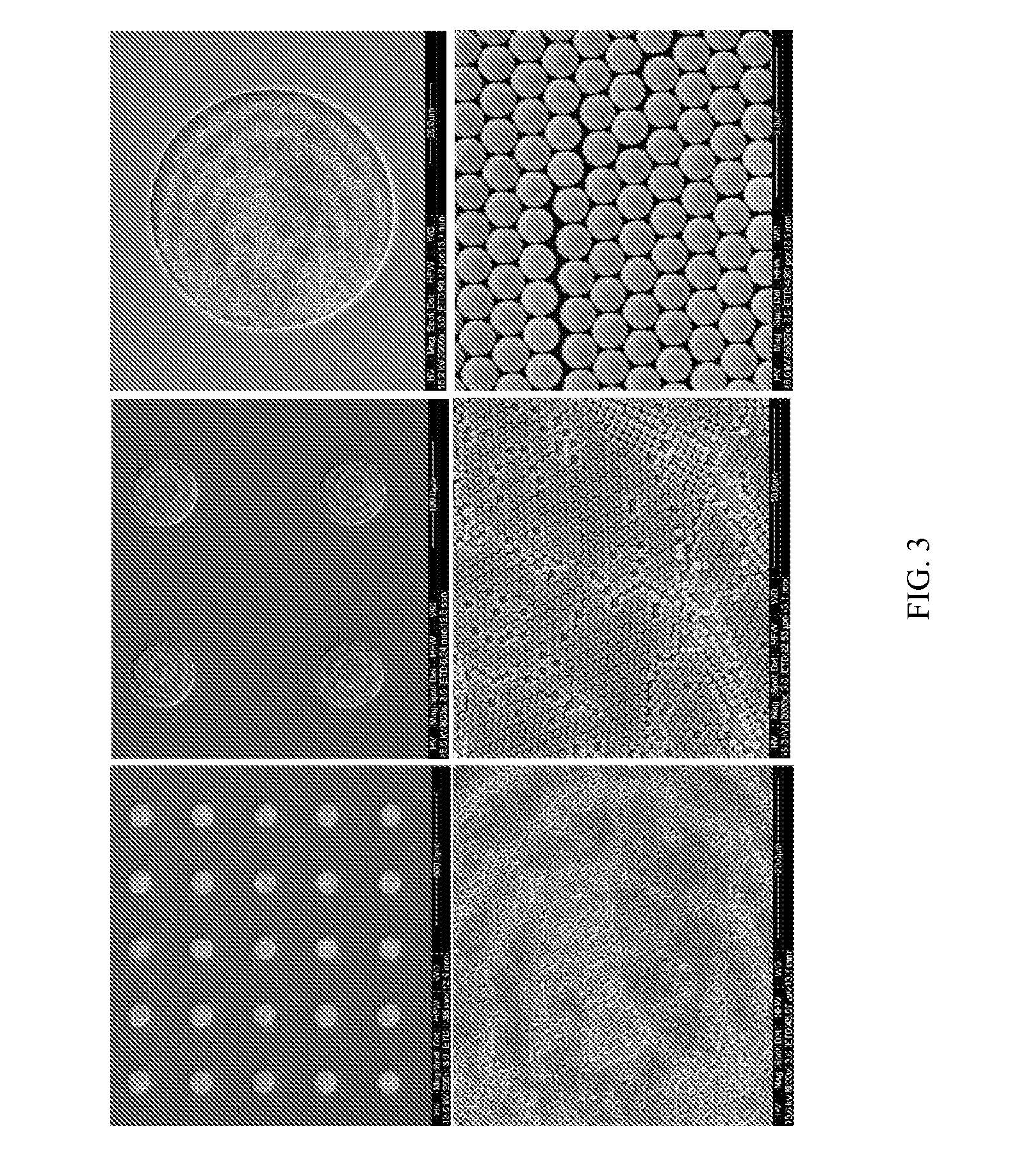Signal amplified biological detection with conjugated polymers
a polymer and conjugated technology, applied in the field of ultra sensitive detection methods for biomolecules, can solve the problems of limiting the conformation and adaptation ability of polymers to the shape of biologically-derived molecules, deleterious fluorescence self-quenching, and rigid rod structure of polymers, so as to reduce non-specific assay interactions and improve water solubility
- Summary
- Abstract
- Description
- Claims
- Application Information
AI Technical Summary
Benefits of technology
Problems solved by technology
Method used
Image
Examples
example 1
Synthesis of monomer, 2,7-dibromo-9,9-di(2′,5′,8′,11′,14′,17′,23′,26′,29′,32′,35′-dodecaoxaoctatriacontan-38′-yl)fluorene (A) for subsequent polymerization
[0216]
Step 1: 2,7-dibromo-9,9-di(3′-hydroxypropanyl)fluorene
[0217]2,7-dibromofluorene (9.72 g, 30 mmol), tetrabutylammonium bromide (300 mg, 0.93 mmol), and DMSO (100 mL) were added to a 3-neck flask under nitrogen (g), followed by the addition of 50% NaOH (15 mL, 188 mmol) via syringe. The mixture was heated to 80° C., and 3-bromopropanol (6.70 mL, 77 mmol) was added dropwise via addition funnel, and the reaction mixture was stirred at 80° C. for another 2 hours. Upon completion, the mixture was cooled to room temperature and quenched with water (250 mL). The aqueous layer was extracted with ethyl acetate (3 150 mL portions). The organic layers were combined, washed with water, then dried over MgSO4, and filtered. The solvent was removed and the residual was recrystallized in chloroform to yield pale yellow needle crystals (9.20 ...
example 2
Synthesis of a branched monomer, 2,7-dibromo-9,9-bis(3,5-(2,5,8,11,14,17,20,23,26,29,32-undecaoxatetratriacontan-34-yl)benzyl)-9H-fluorene, for subsequent polymerization
[0220]
Step 1: 2,7-dibromo-9,9-bis(3,5-dimethoxybenzyl)-9H-fluorene
[0221]2,7-dibromofluorene (4.16 g, 12.8 mmol) and tetrabutylammonium bromide (362 mg, 1.12 mmol) were added to a round bottom flask charged with a Teflon stirbar. Next, 60 mL of dimethylsulfoxide was added to the flask and the mixture was stirred for 5 minutes. A portion of 50% NaOH aqueous solution (5.2 mL) was added followed immediately by 3,5-dimethoxybenzyl bromide (7.14 g, 31 mmol). Over the course of 2 hours the solution changes color from orange to blue. The reaction is stirred overnight. The resulting mixture is slowly poured into 200 mL of water and then extracted with three 100 mL portions of dichloromethane. The organic layers are combined and dried over magnesium sulfate and then filtered. The crude product is purified by column chromatogra...
example 3
Synthesis of a Neutral Base Polymer
[0224]
[0225]Polymerization
[0226]2,7-dibromo-9,9-di(2′,5′,8′,11′,14′,17′,23′,26′,29′,32′,35′-dodecaoxaoctatriacontan-38′-yl)fluorene (0.25 mmol), 1,4-divinylbenzene (32.3 mg, 0.25 mmol), palladium acetate (3 mg, 0.013 mmol), tri-ortho-tolylphosphine, (10 mg, 0.033 mmol), and potassium carbonate (162 mg, 1.2 mmol) are combined with 5 mL of DMF in a small round bottom flask charged with a Teflon coated stirbar. The flask is fitted with a needle valve and put in a Schlenk line. The solution is degassed by three cycles of freezing, pumping, and thawing. The mixture is then heated to 100° C. overnight. The polymer can be subsequently reacted with terminal linkers or capping units using similar (in situ) protocols to those provided in Example 5 or by modifying them post polymerization work up as a separate set of reactions.
PUM
| Property | Measurement | Unit |
|---|---|---|
| length×width×depth | aaaaa | aaaaa |
| pH | aaaaa | aaaaa |
| pH | aaaaa | aaaaa |
Abstract
Description
Claims
Application Information
 Login to View More
Login to View More - R&D
- Intellectual Property
- Life Sciences
- Materials
- Tech Scout
- Unparalleled Data Quality
- Higher Quality Content
- 60% Fewer Hallucinations
Browse by: Latest US Patents, China's latest patents, Technical Efficacy Thesaurus, Application Domain, Technology Topic, Popular Technical Reports.
© 2025 PatSnap. All rights reserved.Legal|Privacy policy|Modern Slavery Act Transparency Statement|Sitemap|About US| Contact US: help@patsnap.com



